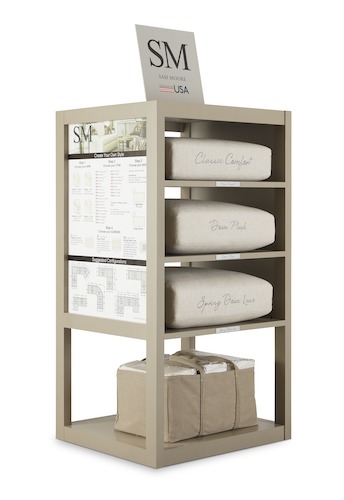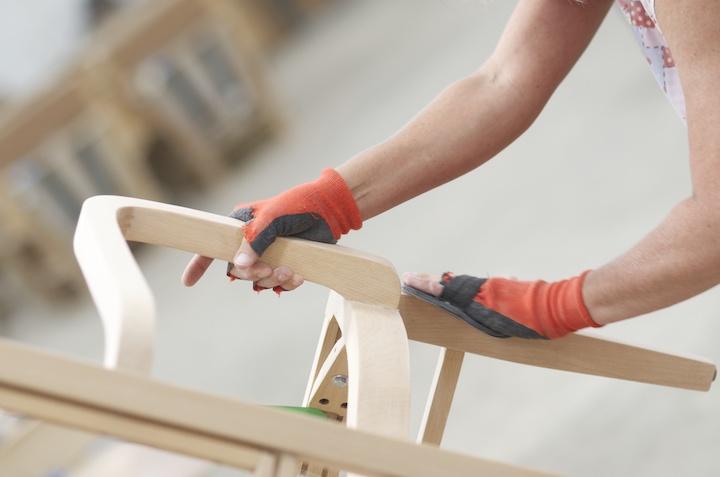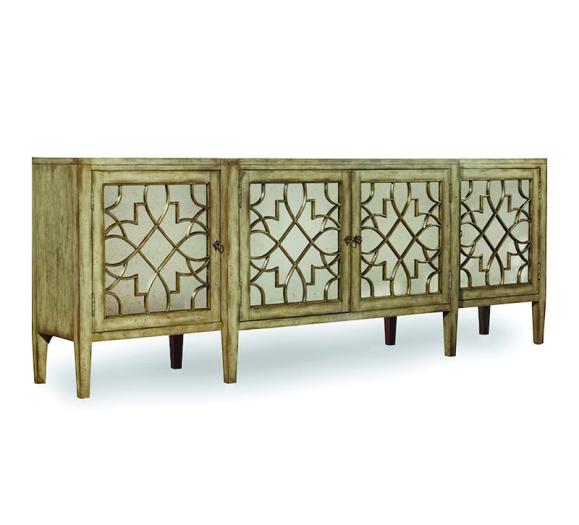Seating comfort is a uniquely personal choice, and quality upholstery can come with an “investment” price tag. Being able to talk about the mechanics, processes, materials and options that go into quality seating is essential on the retail showfloor and when shopping with design clients. “A sofa or sectional for a family room is a very personal purchase,” says Sandi Teague, Vice President of Sales and Merchandising at Sam Moore, which has been crafting upholstered seating in the United States for 80 years. “We get so little family time, it’s important to have that oasis for the time we have.”
For the consumer, seating should be one category where product knowledge and a “test ride” is as important as finding the right color. Yet, as consumers head online to shop, how do we convince them to experience the “sit”? Manufacturers are working to provide the needed knowledge. “We’ve been apostles of the philosophy of loving it first by seeing it, then by sitting on it, and then by pocketbook,” says Dixon Bartlett, Chief Creative Officer for Norwalk Furniture.
According to Bartlett and other manufacturers, there’s a lot of engineering, craftsmanship and testing that goes into seating that provides stability and durability along with a sit that envelops the body. A lot has to happen to ensure the comfort. “Our vision is to construct upholstery that you sit in as opposed to sit on,” says Sean O’Connor, Senior Vice President of Sales at Universal Furniture.
Constructing Comfort
“Good seating begins with a well-built frame, a springing system that provides maximum support, premium cushioning and proper selection of fabric choices that are properly back-coated,” adds Del Starnes, President and Chief Operating Officer at Taylor King.
“In my experience and in the training that I have received from some legendary upholstery mavens, perfecting the ‘sit’ of a chair or a sofa is all about the relationship of the geometry in the frame construction,” adds Dixon Mitchell, President and Chief Operating Officer of Fairfield Chair. “The direct relationship of the seat height and seat depth while integrating the seat draft and back pitch all factor in defining the best sit.”
Beyond pitch, frame materials and spring construction create the foundation for upholstery designed to outlast the trends. That primarily includes strong frames, constructed from solid hardwood or upholstery grade plywood, which can be even stronger than hardwoods.
According to Ellen DeLong, Director of Upholstery and Outdoor Furniture for Century Furniture, the company primarily uses kiln-dried solid hardwoods in their upholstery frames. “For furniture with ornate details it has to be hardwood,” DeLong says. At Century, frames are corner blocked, double doweled and glued to prevent shifting or squeaking. “It’s worth taking the extra time,” she says.
This type of frame construction requires expertise, according to suppliers. For upholstery makers, particularly in the U.S., while finding and training the artisans that craft the furniture can be a challenge, it is well worth the investment. “The way we make our upholstery, it’s all bench made in the time-honored tradition of how it’s been done for 50 years,” Theodore Alexander Vice President of Sales Garth Robinson says. “We tie the springs to each other and to the frame in eight ways ensuring the springs stay stable and consistent. Eight-way hand-tied gives you stability for a great ride.” Whether eight-way hand-tied or sinuous spring, the right spring support system is important. “The gauge of the coil is critical in determining the firmness or softness of the seat,” Fairfield’s Mitchell notes.
Norwalk’s Bartlett adds that the spring system has to match the function. “Depending on the style of the chair, we know what support system we’re going to use,” he says. “It’s important to think about this right in the beginning because how the chair sits is largely built into the frame.”
Sinking In: The Cushion Story
Cushions are where manufacturers offer up myriad comfort and cost options depending on the foam, fill and binding fabrics used for the perfect seat. While each company has its magic formula, there are a few caveats to consider before sinking into a sofa. For example, says Sam Moore’s Teague, there needs to be a “crown” to the cushion. “You want to make sure your cushions aren’t flat,” she says. “You want a comfortable look before you even sit into the sofa.” Sam Moore offers several cushion styles for soft to firmer seating.

There’s nothing better than using the product to attest to the quality of a good cushion, according to Theodore Alexander’s Robinson. “Our standard cushion, which is 90 percent foam core surrounded by a 15/85 down and feather mix, keeps the softness.” He’s had the first sectional made in the company’s custom program for seven years. “It’s the most comfortable sofa I’ve ever sat on,” he says, attributing the comfort to long feathers and the ticking that keeps them in place.
Important too, upholstery manufacturers agree, is the ratio of softness between the seating cushion and seat backs. Fairfield’s Mitchell explains: “Back pillow construction should link to the seat cushion construction. This linkage should match firmness or softness so that the seat and back compliment one another.”
Universal’s O’Connor agrees. The company builds its styles with fully sprung and fully padded backs to ensure an “even ride no matter where you sit,” he says.
Styling with Purpose
As performance fabrics continue to offer a softer hand, better stain and liquid resistance, and increased durability, upholstery companies are also offering more performance options.
“We examine fabric samples to make sure we feel we are not compromising fashion for quality, including considering the amount of double-rubs in the information supplied to us by the mill,” says Taylor King’s Starnes.
O’Connor adds, “We look for a comfortable feel in all our fabrics. We started using performance fabrics four years ago, and they now make up 70 percent of our fabric assortment.”
For upholstery manufacturers, particularly those with custom options, the ability to offer myriad styles add to the appeal. “We like to stay on top of current trends,” says Sam Moore’s Teague. “We make sure we’re reaching all of the different customers out there and meeting their needs.”
Century’s DeLong suggested there are infinite possibilities that can be extracted from upholstery’s basic structure. “We’ll build anything to a customer’s specifications. There are standard changes our customers can make, such as back-fill, cushioning, arm and leg style,” she says. “Or, we can completely product-develop a whole new piece for that client.”
With all of the varied options available in quality seating, experiencing the “sit” is something upholstery makers recommend. “The $800 sofa and $4,000 sofa will look the same online,” Theodore Alexander’s Robinson says, adding the customer will be tossing the $800 sofa in 10 months and re-covering the $4,000 sofa in 10 years. “In the long run, it’s really less expensive.”
Educating the Customer
Upholstery manufacturers understand the mechanics, materials and craftsmanship that go into their quality upholstery seating. How do they share that with their retail and interior design customers so consumers will understand?
“We want every potential customer to test drive the upholstery. Market is a great opportunity for that. We’ve also supported many designer events throughout the country and this ‘see, feel and touch’ experience has proved beneficial. ”
—Sean O’Connor, Universal Furniture
“We developed this program to sell a sofa with graduated cushions, as well as the Cushion Rack. We want the retail salesperson to tell the story easily. They can explain the differences through the diagram, and they can show the cutaway.”
—Sandi Teague, Sam Moore
“We’ve had companies bring their best salespeople through the factory. Once they do, it’s done. They can upsell a customer because they understand the quality level. It’s a hundred little things that make it what it is.”
—Garth Robinson, Theodore Alexander
“We do demonstrations where we tear down chairs so they can see how it’s constructed. Twice a year, we bring retail and design partners to the factory for tours. You see the craftsmanship and quality.”
—Ellen DeLong, Century Furniture
“Before a customer buys a new sofa, ask them how far off the ground the seat of the current sofa is, how deep the seat cushion is, how high the arm is — so you have something to compare with a new sofa. There are many variables. How are you using what you have? Understanding that goes a long way to making a smart consumer.”
—Dixon Bartlett, Norwalk Furniture
“We ask our sales representatives to encourage our dealers, sales associates and designers to always quantify the customers’ desires and needs in comfort and durability.”
—Del Starnes, Taylor King







